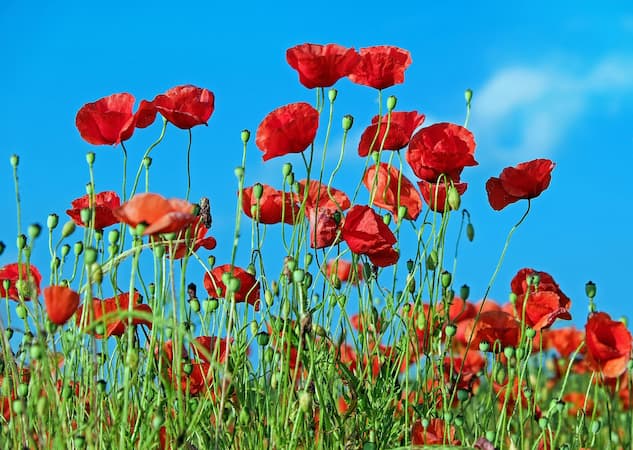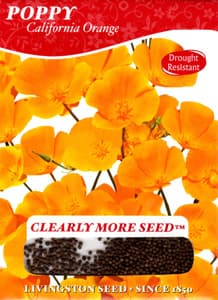How to Grow and Care for Poppy Plants

About Growing Poppies in Your Home Flower Garden
The “World’s Popular Encyclopedia” referred to Poppy plants as “common cornfield weed”. They were then, and continue to be Wildflowers. The year was 1937. However, today, we think of Poppies as a popular and attractive flower, that is common in home gardens as well as open fields. People like growing poppies for the colorful blooms.
Popular is an understatement, as Poppies come in many, many varieties, and are native to many parts of the world, including Central and Southern Europe, China, India, and other parts of Asia. Its popularity also stems from the diversity of its use. In the garden, Poppies are an attractive, easy-to-grow flower in both annual and perennial varieties. As an added bonus, the home gardener can choose from almost any color in the rainbow, including black. Its flowers are long-lasting.
Poppy seeds and oil are popular for baking and cooking. If you have excess seeds, you can put them in your backyard bird feeder.
In the world of medicine, and drugs, some Poppies are a narcotic. It is used to make Codeine, Morphine, and Opium.
Did you Know? After WWII, Poppies became the symbol of both tragedy and renewal of life. They gained this recognition, as there were many poppies in the battlefields of France. Each year on Memorial Day, Veterans sell them as a memorial for those who have given their lives for their country. The proceeds benefit veterans groups.
Poppy Flowers Plant Specifications
Flower Colors: Common poppy colors include orange, pink, red, yellow, and white. Uncommon, or rare colors are black, blue, and purple.
Flowers Bloom: Spring thru summer.
Plant Height: from just 12 inches, up to 3 feet, depending upon the variety
Ideal Soil pH: 6.0 – 7.5.
Hardiness Zones: 2 – 6
Light Requirements: Full sun.
Is the Plant Toxic? Yes and no.
Deer Resistant? Yes. it is somewhat resistant to deer, rabbits, and other foraging animals. However, on some occasions, wild animals may eat the flower blooms.
Native To: Southern California in the United States, and Baja California in Mexico. However, nowadays they are grown all over the world.
Number of Species: There are about 70 species.
Plant Type: Annuals and perennials.
Botanical Name: Papaver
Popular Varieties: California Mission Bells, California Orange, Oriental Red, Iceland Mix, Shirley Double
Are Poppy Flower Plants Edible?
YES!! and NO!!
Only the seeds of some varieties are edible. The plants are not edible.
The seeds of corn poppies are edible. They are popular for use in baking breads, cakes, cookies, and other desserts. Poppy seed salad dressing is popular, too. Poppy seeds are sometimes used in soups and salads, too.
Medicinal Applications for Poppy Flowers
Poppy flowers have a variety of medicinal uses. Here are a few of them.
- As almost everyone knows, extracts from the poppy plant produce a very highly potent pain reliever. This includes codeine, morphine, and opioids.
- Codeine is a cough suppressant.
- It is used in chemotherapy.
- Treat dandruff.
- It relieves irritable bowel syndrome.
Note: The opioid epidemic is the result of recreational use and resulting overdose of opioids. And it is the cause of many deaths in America. Do not use this plant to produce illegal drugs as it is very dangerous.
Light Requirements
For the healthiest, most productive growth, plant poppy plants in a location where they will bright, full sunlight for at least six to eight hours a day.
Poppies grown in lower light levels, do not perform well. They produce smaller and fewer flowers on more delicate stems. And, they are more susceptible to plant disease.

Poppy Plant Propagation
Poppy is grown from seed. Sow seeds directly in the garden. The seeds need sunlight to germinate. So, plant them shallowly.
You can also start seeds indoors. Start Poppy seeds indoors six to eight weeks before the last frost in your area. After planting them in containers, move the seed trays to a sunny window. As previously mentioned, the seed need sunlight to germinate recommend planting them in separate pots, allowing ample room for root growth. This will make transplanting easier. For best results, transplant while still small.
Note: We recommend a heated germination mat, to increase the speed of seed germination. Also, the germination rate is higher.
Days to Germination: 10 – 16 days.
How to Grow Poppy Flower Plants
Poppy plants are very easy to grow. Regardless of whether you are growing annual or perennial varieties, select a planting site where they can grow for many years. Annual varieties will reseed the planting location. Plant them where they will receive full sunlight for all or most of the day. They will grow well in many types of soils and tolerate dry spells well. Poppies look great when grown en masse.
During the initial planting, mix in a generous amount of compost into their new home. Then, plant transplants or seed the area. If you seed the area, you will need to thin them after they reach a couple of inches tall. After planting them, water the area.
The final spacing of plants should be 8″ – 18″, depending upon variety. The plants will grow up to 3 feet tall. They tolerate a little crowding.
Poppies look superb when planted together in big beds. They are excellent wildflowers, filling a field in bright blooms during the summer. The plants grow quickly and will bloom in early to mid-summer. Fertilize them once a month to promote steady growth.
Water the plants as needed. The goal is evenly moist soil all season long. This is very important during hot, dry periods as the plants need plenty of soil moisture to take up into the plant and blooms.
Mulching around the plants helps to keep weeds down and makes the bed more attractive.
Flower Growing Tip: To prolong blooming, grow smaller groups in succession.
Deadhead flowers to prolong blooming.
How to Grow Poppy Flowers in Flowerpots and Containers
Poppies are ideal candidates to grow in containers, flowerpots, and windowsill planters. The plants tolerate a little crowding. So, they will thrive together in a group. Shorter varieties also look good in windowsill planters. Their bright, cheery blooms will brighten up any area where you grow them. Choose your favorite colors. Or, look for colors that match the setting where they will grow.
In addition to the normal steps for growing them, here’s how to care for them in a flowerpot or container:
- It is important to have a drain hole to allow excess water to drain from the pot.
- Keep an eye on the moisture level. Check the plants every day or two, especially in extended periods of hot, dry weather.
- Keep the soil moist, but not wet. It is okay to let the top of the soil begin to dry between watering.
- When watering the plants, thoroughly wet the soil. Excess water will drain through the hole in the bottom of the flowerpot.
- Nutrients in a flowerpot are limited. So, use fertilizer spikes to feed the plants. Or, apply a light solution of liquid fertilizer once a month.
- Select a sunny to partly sunny location on your deck.
Pruning Poppy Plants
Poppy plants require little if any pruning. When growing in fields as wildflowers, or en masse in large groups, pruning is generally impractical. However, when grown in containers or in small groups, you may find occasional use for pruning shears. Remove any dead or broken stems and leaves. Prune off any diseased stems as soon as you spot them.
Removing spent blooms, when practical, will help to promote more blooms.
If you want to harvest some of the seeds, leave a few spent blooms on a couple of the plants.
More on Deadheading Spent Flower Blooms.
Insects and Plant Disease
The plants are fairly resistant to insects and disease. However, if insect or disease problems occur, treat early with organic or chemical insect repellents and fungicide.
Plant Problems – Identify the causes and find the cures.
Overwintering Poppy Plants
If you are growing Poppy flowers as annuals, simply pull up the plants after the first killing frost in the Fall. Then, toss the plants into your composter or compost pile.
Overwintering Poppies Plants Outdoors
Cut the plant back to about eight to ten inches tall. Then, apply a thick layer of mulch over the root area. In the early spring, rake off the excess mulch.
For Overwintering Poppies Plants in Containers
If left outdoors in cold northern climates, the roots can freeze. This will damage or kill them. So, plan on sheltering the containers from the most brutal winters. First, cut the plant back a few inches. Then, bring the container into a cool garage or shed. Bring the containers back onto your patio or deck in mid-spring.
Related Articles
Also, people who read this article on Poppy flowers will like:
How to Grow Poppy Plants – by Garden Hobbies
Please support our site. Shop for:
- rmmatthews100@hotmail.com
- 585-721-6528
- Rochester, NY
©1999-2024 GardenersNet.Com, All Rights Reserved

